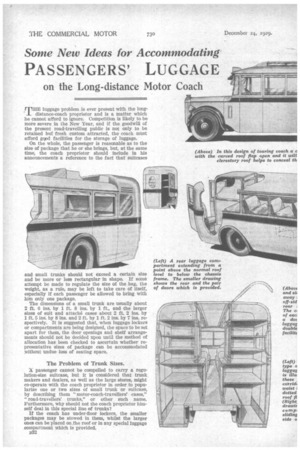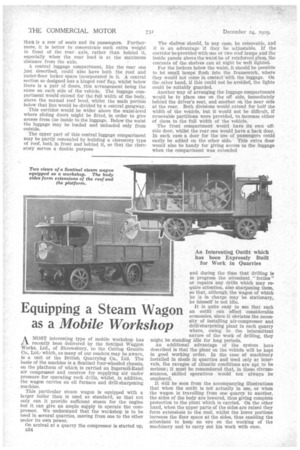Some New Ideas for Accommodating
Page 50

Page 51

Page 52

If you've noticed an error in this article please click here to report it so we can fix it.
PASSENGERS' LUGGAGE
on the Long-distance Motor Coach
THE luggage problem is ever present with the longdistance-coach proprietor and is a matter which he cannot aftOrd to ignore. Competition, is likely to be more severe in the New Year, and if the goodwill of the present road-travelling public is not only to be retained buf fresh custom attracted, the coach must afford good facilities for the storage of luggage.
On the whole, the passenger is reasonable as to the size of package that he or she brings, but, at the same time, the coach proprietor should include in his announcements a reference to the fact that suitcases and small trunks should not exceed a certain size and be more or less rectangular in shape. If some attempt be made to regulate the size of the bag, the weight, as a rule, may be left to take care of itself, especially if each passenger be allowed to bring with him only one package.
The dimensions of a small trunk are usually about 2 ft. 6 ins. by 1 ft. 8 ins. by 1 ft., and the larger sizes of suit and attaché cases about 2 ft. 2 IDS. by 1 ft. 5 ins. by 8 ins. and 2 ft. by 1 ft. 2 ins. by 7 ins. respectively. It is suggested that, when luggage lockers or compartments are being designed, the space to be set apart for them, the door openings and shelf arrangements should not be decided upon until the method of allocation has been checked to ascertain whether representative sizes of package can be accommodated without undue loss of seating space.
The Problem of Trunk Sizes.
passenger cannot be compelled to carry a regulation-size suitcase, but it is considered that trunk makers and dealers, as well as the large stores, might co-operate with the coach proprietor in order to popularize one or two sizes of small trunk or suitcase, by describing them " motor-coach-travellers' cases," "road-travellers' trunks," or other such name. Furthermore, why should not the coach proprietor himself deal in this special line of trunks?
If the coach has under-floor lockers, the smaller packages may be stowed in them, whilst the larger ones can be placed on the roof or in any special luggage compartment which is provided.
B32
The under-floor luggage locker has the advantage that it allows a slight increase in seating capacity, instead of reducing it, as will any internal compartment. The raised floor also gives the passenger a clear view of the countryside. The observation coach, with its raised rear compartment, had space for an ideal luggage locker beneath it, but events have proved that the travelling public did not take kindly to this design of vehicle. It may, however, shortly be reintroduced—perhaps in a modified form.
Now that roof lockers are becoming established praC tice, as are under-floor ones, it is suggested that, if part of the main saloon be set aside for luggage, all three features might be combined in one. That is to say, the luggage compartment would reach from the top of the usual roof-locker level to the bottom of the skirt locker. If such a luggage compartment be set out at the rear, it could then be made unobtrusive by having a dome-shaped top back panel, with side windows, the latter, however, being of opaque glass. The back of this compartment would be supplied with a pair of large doors.
The medium-sized trunks would be carried below, with suitcases and smaller packages arranged on shelves above. The back doors would have an upper window of opaque glass of elliptical outline, or of any other shape, such as is used for the back of the usual pattern of coach.
A Good Position for Luggage:
Now that the buffet and lavatory are not in favour, the space formerly occupied by them may well be used for luggage. The rear compartment, as just described, occupies such a position. These first and second-named sections were, however, also set out in the centre and, occasionally, in the front of the coach.
The central position is suitable, because a wellpacked luggage compartment may easily be heavier
than is a row of seats and its passengers. Furthermore, it is better to concentrate such extra weight in front of the rear axle, rather than behind it, especially when the rear load is at the maximum distance from the axle.
A central luggage compartment, like the rear one just described, could also have both the roof and under-floor locker space incorporated in it. A central section so designed has a hinged roof flap, whilst below there is a pair of doors, this arrangement being the same on each side of the vehicle. The luggage compartment would extend for the full width of the body, above the normal roof level, whilst the main portion below that line would be divided by a central gangway. This corridor would be wider above the . waist-level where sliding doors might be fitted, in . order to give access from the inside to the luggage. Below the waist the luggage may be loaded and unloaded only from outside.
The upper part of this central luggage compartment may be partly concealed by building a clerestory type of roof, both in front and behind it, so that the clerestory serves a double purpose • The shelves should, in any case, be removable, and it is an advantage if they be adjustable. If the corridor be 'provided with one or two roof lamps and the inside panels above the waist be of reinforced glass, the contents of the shelves can at night be well lighted.
For the lockers below the waist, it should be possible to let small lamps flush into the framework, where they would not come in contact with the luggage. On the other hand, if this could not be avoided, the lights could be suitably guarded.
Another way of arranging the luggage compartments would be to place one on the off side, immediately behind the driver's seat, and another on the near side at the rear. Both divisions would extend for half the width of the vehicle, but it would not be difficult, if removable partitions were provided, to increase either of them to the full width of the vehicle.
The front compartment would have its own offside door, whilst the rear one would have a back door. In each case a door for the use of passengers could easily be added on the other side. This extra door would also be handy for giving access to the luggage when the compartment was extended




































































































